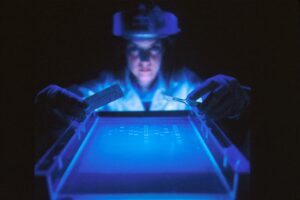DNA testing revolutionized the criminal legal system. Since its first use in a United States courtroom in 1986, it has become the leading method to assist law enforcement and attorneys in determining a suspect’s guilt or innocence. Not only that, the ability to request post-conviction DNA testing has given many people who were wrongly accused an opportunity to prove they’re innocent, often years or even decades after their conviction.
DNA
What exactly is DNA? Every living being has a genetic code that codes the body into every individual’s unique characteristics. When called upon, forensic scientists often use two types of DNA to rule out suspects.

The first type, nuclear DNA, is composed of a double helix ladder made of four chemicals (adenine (A), thymine (T), guanine (G), and cytosine (C). These chemicals pair together in their unique orders to form steps on two ladders that, when they pair together form an “X” shape, called a chromosome. The order and number of these chemical pairs decide your unique traits.
The second is mitochondrial DNA (mtDNA) is formed by the same chemicals above (ATGC), but in a circular shape. mtDNA is passed from the maternal line to their children. Therefore, every family member related through the maternal line has the same mtDNA as their relatives. mtDNA testing is not as useful to help identify suspects but can help rule them out or work with really old or degraded evidence.
In modern crime scenes, a forensic team will arrive at the scene to assess the evidence, take photos, and gather all types of evidence such as fingerprints, blood, and saliva. Teams must be extremely cautious to not contaminate the scene or the evidence because even a very small drop of blood or saliva may be enough to identify or eliminate a potential suspect as the perpetrator of a crime. Now, due to the development of a technique called “polymerase chain reaction” (or PCR) which makes copies of existing DNA, analysts can extract a DNA profile from even the smallest of DNA samples.
FORENSIC SCIENCE
The forensic sciences encompass an array of sciences to assist us in analyzing evidence found at the scene to aid in identifying a perpetrator. Forensic scientists help law enforcement and attorneys in criminal cases by explaining the relevance of the evidence such as DNA, fingerprints, bullet trajectories, and many others. They are also useful in aiding juries to understand the relevance of the evidence presented in court. Reliable forensic testing can greatly help to make sure the true perpetrators are convicted and the innocent remain free.
Forensic science, like any other technology, becomes more sophisticated every day. Scientific advancements have shown that science once thought to be very reliable, no longer should be used. For example, some forensic techniques such as arson investigations (determining whether a person intentionally set a fire or if it was accidental) or forensic odontology (the analysis of bite marks in criminal cases) were historically considered to be reliable “sciences,” but are now called into question. The 2009 National Academy of Sciences report called out nearly every forensic science for having serious flaws, specifically noting many were not using standardized terms and reporting practices, there was a lack of a control group to receive accurate error rates, and many failed to account for the biases of scientists performing the tests. Many forensic disciplines still had the same issues in 2016, which was documented by the President’s Council of Advisors on Science and Technology (PCAST). The PCAST report concluded many of the disciplines lacked scientific reliability and validity.
If you are interested in learning about wrongful convictions caused by the misuse of forensic “sciences,” we direct you to read about JoAnn Parks, Alan Gimenez, and Suzanne Johnson.

